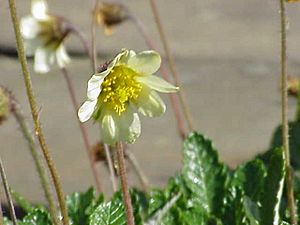Dryadoideae facts for kids
Quick facts for kids Dryadoideae |
|
|---|---|
 |
|
| Dryas × suendermannii | |
| Scientific classification | |
| Kingdom: | |
| (unranked): | |
| (unranked): | |
| (unranked): | |
| Order: | |
| Family: | |
| Subfamily: |
Dryadoideae
|
| Genera | |
|
Cercocarpus Kunth |
|
The Dryadoideae are a special group of plants that belong to the Rosaceae family, which you might know as the rose family. What makes these plants unique is that they all work with tiny helpers called Frankia bacteria. These bacteria live in the plants' roots and help them get an important nutrient called nitrogen.
Contents
What are Dryadoideae Plants?
The Dryadoideae group includes four main types, or genera, of plants. These are:
- Cercocarpus
- Chamaebatia
- Dryas
- Purshia (which includes Cowania)
These plants are usually small. They can be:
- Subshrubs: Plants that are partly woody and partly soft.
- Shrubs: Bushy plants with many woody stems.
- Small trees: Like regular trees, but not very tall.
Special Roots: Nitrogen Fixation
One of the most amazing things about Dryadoideae plants is how they get nitrogen. Nitrogen is a gas that plants need to grow strong and healthy. It's all around us in the air, but plants can't use it directly.
This is where the Frankia bacteria come in! These tiny bacteria live inside special bumps on the roots of Dryadoideae plants. They can take nitrogen gas from the air and change it into a form the plant can use. This process is called nitrogen fixation. It's like the bacteria are giving the plant a special fertilizer.
In return, the plant gives the bacteria a place to live and food. It's a great example of teamwork in nature!
Fruits of Dryadoideae
The fruits of Dryadoideae plants are usually small and dry. They can be:
- Achenes: These are small, dry fruits that contain one seed. The seed is not attached to the fruit wall. Think of a sunflower seed – that's an achene!
- Aggregate of achenes: Sometimes, a single flower can produce many achenes that are grouped together. This is called an aggregate fruit.
See also
 In Spanish: Dryadoideae para niños
In Spanish: Dryadoideae para niños

